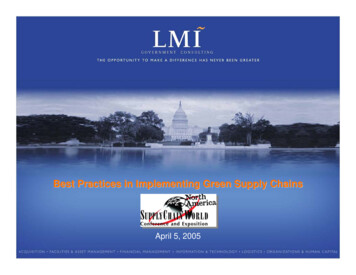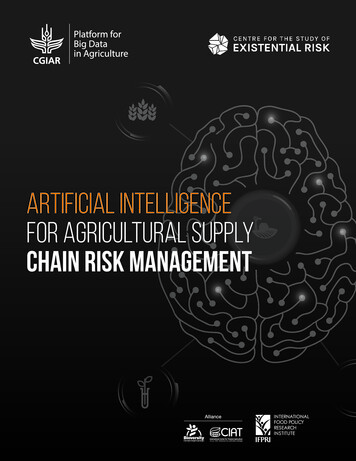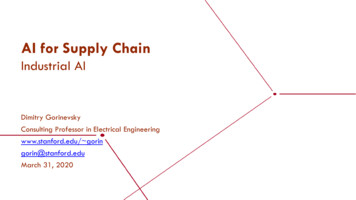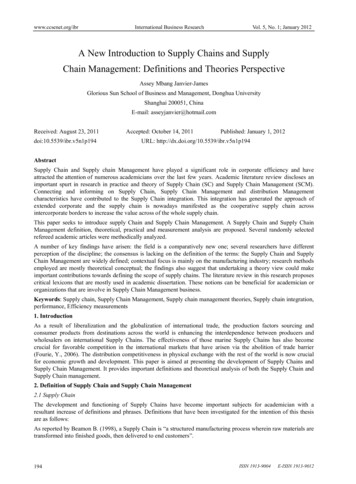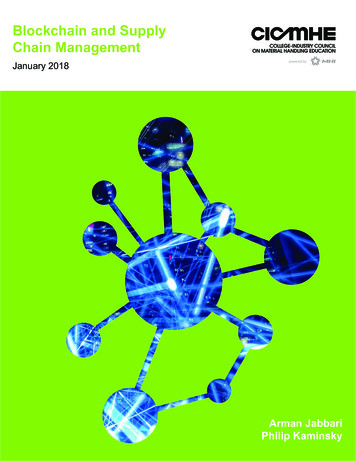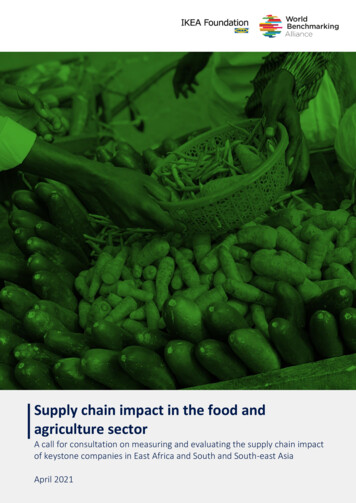
Transcription
Supply chain impact in the food andagriculture sectorA call for consultation on measuring and evaluating the supply chain impactof keystone companies in East Africa and South and South-east AsiaApril 2021
ContentsIntroduction. 1Acknowledgements. 1About the World Benchmarking Alliance . 2WBA’s theory of change . 3WBA’s Food and Agriculture Benchmark . 4Shining a light on supply chain impact in the food and agriculture sector . 4Project overview . 7Project timeline . 8Project dimensions . 8Mapping the focus regions . 10Defining what influences sustainability in supply chains . 11Defining the sustainability issues that influence supply chain impact . 13Methodology . 15Measuring impact over time . 16Limitations . 17Annex 1: WBA’s funding partners . 19Annex 2: Countries in scope . 19
IntroductionThis paper outlines the scope and aims for a project that will explore the linkages between companies’performance on material sustainability topics and their subsequent impact on the ground at the local level.In particular, it will evaluate how companies create change within their regional supply chains and howbenchmarking – by which we mean a publicly available and free ranking of corporate sustainabilityperformance – can speed up the transformation of the global food system. With the support of the IKEAFoundation, the World Benchmarking Alliance (WBA) will implement this project within an initial timeframeof three years.WBA has selected 350 keystone companies – those with a disproportionate impact on the global foodsystem – for its first Food and Agriculture Benchmark, which will be launched at the UN Food SystemsSummit later this year. The benchmark will evaluate the performance of companies on key environmental,nutritional and social inclusion topics. This project will dive deeper into the supply chain impact of a selectionof these companies, based on the significance of their footprint in the two project focus regions of EastAfrica and South and South-east Asia. These regions were chosen because of their centrality in the globalfood system and the need to embrace a global transformational agenda. Moreover, while interest in thesustainability performance of companies’ own operations is well established in research and policy, it is onlyin recent years that this has extended to companies’ supply chains. However, the availability of data in thisarea remains limited. Therefore, the purpose of this project is also to gather data on companies’ supplychain performance and to better understand the dynamics of this aspect of companies’ value chains.The following pages outline the urgent need for a greater understanding of supply chain impact, thecharacteristics and sustainability topics that may determine this impact and the proposed methodology forthis project. By publishing this paper, we hope to elicit additional input from stakeholders on the proposedapproach and methodology. We also present four key consultation questions and seek explicit inputthroughout the paper. Please send any feedback directly to Nathan Cable(n.cable@worldbenchmarkingalliance.org) and Will Disney gementsWBA would like to thank the IKEA Foundation, which financially supports both the development of the Foodand Agriculture Benchmark and this monitoring, evaluation and learning (MEL) supply chain project. AcrossWBA, our work is funded by a group of governments, foundations and philanthropic organisations that shareour vision for the future. We would also like to thank them for their support, without which none of ourwork would be possible. A full list of WBA’s funders is set out in Annex 1.Furthermore, during the early stages of our partnership, we engaged with a group of WBA Allies, IKEAFoundation project partners and members of our Expert Review Committee to discuss our approach to thisproject and gather feedback from those with thematic and/or regional expertise. These conversationshelped form the approach and structure presented in this paper. We would like to extend our thanks to thefollowing organisations: Aceli AfricaAidenvironmentAlliance for a Green Revolution inAfrica (AGRA)Centre for Responsible Business Meta/MetaOxfamRoot CapitalScaling Up Nutrition (SUN) BusinessNetwork: country representatives fromSupply chain impact in the food and agriculture sector: a call for consultation1
EcochainEllen MacArthur FoundationGlobal Alliance for the Future of FoodGlobal Alliance for Improved Nutrition(GAIN)Hand in Hand InternationalInternational Institute forEnvironment and DevelopmentKilimo TrustKudos Africa Mozambique, Bangladesh, Sri Lanka,Kenya, Uganda, Laos, Cambodia,Philippines and MyanmarSolidaridadSustainable Trade Initiative (IDH)Swasti/Catalyst Management ServicesWBA Food and Agriculture ExpertReview Committee (list of membersavailable here)WWF IndiaAbout the World Benchmarking AllianceWBA brings together a diverse and growing group of organisations from across the globe that are motivatedby the common ambition to create a world that works for all – as embodied by the Sustainable DevelopmentGoals (SDGs). We share the vision that achieving these goals requires a systems perspective, as the 17 SDGsare interlinked. We also agree that to accomplish systemic transformation, the private sector has a key roleto play. WBA uses a systems approach to develop benchmarks, placing a strong emphasis on transformingthe systems that have the greatest potential to drive economic, environmental and social progress. Systemsthinking helps us make better sense of the issues as well as identify the most influential companies in eachsystem. By 2023, WBA will have benchmarked 2,000 companies – the SDG2000 – across seven systemstransformations that we believe are vital for putting our society, planet and economy on a more sustainableand resilient path over the next decade and beyond (see Figure 1). Benchmarks will be produced for allseven systems, of which food and agriculture is one, with accompanying methodologies helping to supportsystems change.Supply chain impact is an important consideration forcompanies across all of WBA’s seven systems and thevarious industries that sit within these. Therefore, theframework for this food and agriculture-specific projectwill be developed to be relevant for these systems, inorder to be applicable and transferable in the future.Figure 1: WBA’s seven systems transformationsThe social transformation sits at the core of the model because it represents topics such as human andlabour rights that are fundamental to achieving the SDGs, irrespective of the sector or transformation. Forthis reason, all SDG2000 companies will be assessed on these social topics, including the companies in theFood and Agriculture Benchmark.Supply chain impact in the food and agriculture sector: a call for consultation2
WBA’s theory of changeFigure 2: WBA’s theory of changeWBA’s institutional theory of change (ToC) (Figure 2) sets out the desired impact of WBA’s benchmarks andhow that impact will be achieved. The ToC comprises: Activities: WBA undertakes multi-stakeholder dialogues (involving companies, civil society, investorsand policymakers), develops methodologies and indicators, collects data and assesses companiesacross seven systems transformations while growing the Alliance of partners.Outputs: our activities result in publicly available and free methodologies and benchmarks as well asgrowth of the Alliance.Outcomes: based on our outputs (methodologies and benchmarks), companies respond actively andstakeholders take action. This in turn leads to accelerated company efforts towards moresustainable practices.Impact: accelerated company efforts towards more sustainable practices ultimately result intransformed systems and improved business impact on people, workers, communities and theenvironment, particularly in developing countries.This project will provide a deep dive into WBA’s institutional ToC and outcomes by assessing the influence ofkeystone companies on behaviour change and improved sustainable practices among selected supply chainpartners across our two focus regions. By evaluating influence beyond the scope of companies’ directoperations, WBA will provide a more comprehensive insight into companies’ ability to achieve holisticsystemic change and tackle global sustainability challenges at a broader scale. We aim to learn whichpractices speed up or slow down the transformation, and which activities and outcomes are most importantto the change. Furthermore, the project’s three-year cycle will allow for two full rounds of impact evaluation.This will enable us to track progress made by companies in terms of influencing more sustainable practices intheir supply chains as well as contributions made to WBA’s desired impact of transformed systems andimproved business impact on people, workers, communities and the environment, particularly in developingcountries.Supply chain impact in the food and agriculture sector: a call for consultation3
WBA’s Food and Agriculture BenchmarkFood systems contribute to economic prosperity, human health and planetary health. Meanwhile, poor dietsare the main contributor to the global burden of disease. Approximately 3 billion people cannot afford ahealthy diet, and more than 3 billion people suffer from at least one manifestation of poor nutrition. Theglobal population is predicted to reach 9.7 billion by 2050, but food systems are already operating beyondsome planetary boundaries. Agriculture and its associated land-use changes are the biggest contributors toclimate change, land degradation, deforestation and biodiversity loss. The need for fundamentaltransformation of food systems has become undeniable. Food system transformation ties in theseinterconnected aspects of human and environmental health and livelihoods and links them to key globalagendas including the SDGs and the Paris Agreement.The Food and Agriculture Benchmark takes a holistic approach to food system transformation, assessing 350keystone companies throughout the value chain on a broad set of indicators in four measurement areas:governance and strategy, environment, nutrition and social inclusion. As such, the benchmark seeks toassess the role and performance of companies and industries and provide robust evidence of companiesshowing leadership and stewardship and those that are lagging behind. The research further aims to showwhere each company in the food and agriculture value chain stands today versus what action is required forthe transformation we need. For a detailed insight into how companies will be assessed, you can access thefull benchmark methodology here.While the Food and Agriculture Benchmark will measure and compare companies’ performance on aspectsof their supply chains, it will not exclusively focus on this area. Indeed, the intention of the benchmark is tocapture and measure sustainability performance across a company’s entire value chain, of which aspects ofsupply chain performance are considered. Therefore, this project will act as an extension of the Food andAgriculture Benchmark by conducting a deep dive into the topic for a select group of keystone companiesand shining a light on the impact of supply chains in the food and agriculture sector.Shining a light on supply chain impact in the food and agriculture sectorTo measure and evaluate the impact of keystone companies, we first need to understand their supplychains: where they extend to, what is being sourced, how they are modelled and governed, and the make-upof the relationships within them. Today’s agri-food system is complex and interconnected. Actors across thevalue chain are linked by horizontal and vertical cooperation, forward and backward integration in the supplychain and continuous innovation,1 with significant challenges including the perishability of products, longproduction cycles and seasonality, and high degrees of variability in both the quality and quantity of supply.2Like many other systems, the agri-food system has become increasingly globalised in recent years, driven byreduced barriers to international trade, the rise of multinational corporations and consumer demand.3 Theincreasingly globalised nature of the industry has also seen its value rise rapidly, with the trade ofcommodities such as palm oil, beef and soya generating billions of dollars of investments in both producingand consuming nations.4 In producing nations, more than 400 million people live on the cultivation of theseand other commodities, typically in small-scale or cooperative farming structures.5 Yet these people oftenlack the finance, market access and bargaining power to earn a sustainable livelihood and living income inthese global value chains.6WBA’s 350 keystone food and agriculture companies, headquartered in 41 different countries, are billiondollar multinational enterprises and have a vast collective supply chain presence – one which significantlyexceeds their direct operational presence. However, the full extent of their supply chains is not wellSupply chain impact in the food and agriculture sector: a call for consultation4
understood, hampered by a collective lack of transparency due to minimal corporate disclosure. Greatertransparency can play a significant role in demystifying complex supply chains, helping stakeholders toidentify and minimise risk and improving conditions on the ground.⁴ However, initial research by WBA hasshown that the majority of keystone companies have little or no public information available on theirsourcing activities, such as the origins of key agri-commodities or locations of major suppliers. Whiledisclosure is improving in some areas, particularly in relation to commodities such as palm oil and cocoa, it israre for keystone companies to disclose information beyond their tier 1 supply chain partners.The importance of establishing a more detailed understanding of food and agriculture supply chains isdemonstrated by the fact that the impact of these chains on natural capital (such as air, soil and land) isestimated to be 24 times higher than the impact of direct company operations. Similarly, indirect scope 3greenhouse gas (GHG) emissions are estimated to be 5.1 times higher than direct scope 1 and 2 GHGemissions in the agriculture sector.7 Inequality and human rights abuses, while endemic in the globaleconomy, are often exacerbated in supply chains, and particularly in agriculture when it comes to issuessuch as child labour, forced labour and paying a living wage.8 As such, the ultimate drivers of environmentaland social change in producer countries are often disconnected from the places where the majority ofimpact materialises, especially when change is being driven by consumption patterns in North America,Europe and China.⁴However, this disparity in impact is not reflected in the level of corporate commitments in place to addressthese issues. WBA’s food and agriculture baseline assessment, published in December 2020, found thatwhile 35% of keystone companies committed to reducing their scope 1 and 2 GHG emissions, only 11%disclosed commitments that also covered their scope 3 GHG emissions. Similarly, while 64% of companiesdisclosed commitments to reduce freshwater use in their own operations, only 25% also consider the role oftheir supply chains and their dependencies in water-stressed areas. With 40% of companies lacking acommitment to eliminate child labour in either their operations or supply chains, a clear pattern emerges ofcompanies failing to address holistically both their operational and supply chain impact in sustainabilitystrategies and corporate commitments.Another challenge to unpack is the various structures of agri-food supply chains and the relationships andpower dynamics within them. Historically, these supply chains have been characterised by asymmetricpower relations in favour of larger downstream companies, typically headquartered in Western countriesalthough more recently joined by emerging economies such as China, which adversely affects thedistribution of risk and reward along the chain.9 Traditionally dominant ‘buyer group’ characteristics, such aslarge purchase volumes, standard or undifferentiated products (in the case of agriculture, commodities suchas grains, oilseeds, cocoa and coffee) and purchase products forming a significant fraction of the cost andtherefore making buyers more cost-sensitive,10 can all be attributed to large-scale downstream players in theglobal agri-food system.In addition to traditional power imbalances, the ways in which companies source agricultural commoditiesand products can vary greatly – be it directly from farmers, through cooperatives or wholesalers, or usingintermediaries or commodity markets.11 This can also vary between different commodities, even if sourcedby the same company. Intermediaries, for instance large-scale commodity traders, third-party certifiers andcredit agencies, play increasingly important roles in areas such as information and knowledge transfer,codification through standards and increasing supplier capacity.12 However, longer supply chains (those withgreater numbers of actors and intermediaries between the producer and end-purchaser or consumer) havebeen shown to limit the value provided to producers and weaken local development13 as well as makingtraceability back to the farm level increasingly difficult. Without this understanding of the source orSupply chain impact in the food and agriculture sector: a call for consultation5
geography of origin of a given product or commodity, and the point at which multinational companiesstrategically enter the supply chain, it is difficult to evaluate company impact.A sustainable supply chain is one that ‘manages environmental, social and economic impacts and works forgood governance throughout the life cycle of products and services. The goal of a sustainable supply chain isto create, protect and grow long-term value for all stakeholders involved in the presence of products andservices on the market’.14 Given the challenges outlined above, how can this outcome be achieved in agrifood supply chains?The International Institute for Environment and Development, a WBA Ally, has described several keyprinciples, including chain-wide collaboration in the allocation and use of resources and management ofoutcomes, giving smallholders a voice in the adoption of new ideas and technologies, and fair andtransparent governance relating to decision-making and the way in which actors participate in the chain.15OECD-FAO guidelines stress the need to design, report on and verify robust due diligence processes foraddressing supply chain risks,16 while Fairtrade Nederland recommendations include longer term contractswith greater transparency on prices and trading conditions, prices that enable living wages to be paid andbalanced mechanisms for negotiations and resolving disputes.17 Supporting the organisation of farmercooperatives can bring numerous benefits to small producers, including a structure for improved education,lowered input prices through aggregated demand, stronger bargaining positions for bigger markets andbetter pricing, and reduced reliance on intermediaries or local traders.6 Finally, assigning board or executivelevel responsibility for supply chain governance can help to ensure the necessary implementation andoversight of relevant policies and codes of conduct.18The World Business Council for Sustainable Development, another WBA Ally, recently published an issuebrief on vital supply chains, highlighting how existing issues and inequalities in food and agriculture supplychains have been exacerbated by the ongoing COVID-19 pandemic. Among these are limited access toresources and credit for (female) smallholder farmers, reduced availability and affordability of healthy andnutritious food and critical increases in food loss stemming from border disruptions and transportationdelays.More data, disclosure and transparency sit at the heart of many of the suggestions for transitioning toequitable and sustainable supply chains, and as such are the first steps on the journey to understanding,managing and mitigating supply chain risks. Without addressing these challenges, a holistic transformation ofthe food system is impossible. Unfair trading practices, unsustainable production methods and human rightsviolations cannot be fully understood, addressed and eradicated if both companies and externalstakeholders lack a basic overview of what, where and from whom products are sourced.Supply chain impact in the food and agriculture sector: a call for consultation6
Project overviewFigure 3: Project overviewThis project will serve two major functions: firstly, to evaluate the relationship between benchmarkperformance and measurable supply chain impact in the two focus regions; and secondly, to assess theinfluencing factors that determine this impact. In order to explore this, we will examine how keystonecompanies structure their regional supply chains, how and where they work with small producers, small andmedium-sized enterprises (SMEs), larger regional companies and intermediaries, the degree to which theyhave leverage and influence over their supply chains and partners, and how they use this to effecttransformational change within the food system.In order to evaluate the relationship between benchmark performance and supply chain impact, we need toengage with the regional supply chain partners of our keystone companies. To do so, we need to know whothese partners are, which emphasises WBA’s call for greater supply chain disclosure from our keystonecompanies. As one effort to address this, supplementary questions will be included in the questionnaire sentto all companies to collect data for the first Food and Agriculture Benchmark in 2021. In answering thesequestions, companies will be requested to provide additional information related to their regional impactacross their operations, supply chains and product sales. Furthermore, while benchmarks are company-ledexercises and evaluate performance from this top-down perspective, WBA intends to use this project as ameans of engaging with and gathering input from those located upstream in the supply chains of keystonecompanies. By doing so, we will determine not only the extent to which companies influence the behaviourand business activities of their supply chain partners, but also how these partners are looking to tackle keysustainability issues themselves. As demonstrated in the most recent iteration of the Access to Seeds Index(a WBA ‘spotlight’ benchmark that sits within the broader food and agriculture transformation), regionalSupply chain impact in the food and agriculture sector: a call for consultation7
home-grown SMEs often have competitive advantages over global companies in areas such as productdistribution and capacity building.Therefore, the project will explore the dynamics, structures and relationships in keystone company supplychains from the perspective of the companies themselves and their regional partners. We will evaluate theextent to which the characteristics of these supply chains influence the ability of these actors to collectivelytackle key sustainability issues across East Africa and South and South-east Asia. The results will help todeepen our understanding of the overall supply chain impact of keystone companies in these regions,allowing WBA to determine the extent to which performance on these issues in the Food and AgricultureBenchmark is reflected in companies’ impact on the ground across the two regions.Project timelineWBA and the IKEA Foundation began a partnership in mid-2020. The development process for this paperinvolved stakeholder engagement with the organisations named in the ‘Acknowledgements’ section. We willfinalise the selection of companies for the project by mid-2021. In the second half of the year, we willengage with these companies and their regional partners and begin the process of additional data collection.The first-year assessment (or ‘baseline’) for this project will be carried out and published in early 2022, usingthe results from the first Food and Agriculture Benchmark as a reference. We will repeat this process in2022/3. The project is due for completion in 2023. At this point, WBA will publish a final project report,detailing the supply chain impact of the keystone companies over two full project cycles, including ananalysis of changes or improvements seen with respect to supply chain impact over the two cycles.Project dimensionsDemonstrate the role ofkeystone companies ininfluencing system changethrough their regional supplychainsSignal to companies theimportance of supply chaintransparency and performanceThis is a central aim of the project and is explored in depth throughoutthis paper.A desire for greater corporate disclosure and transparency is beingdriven by multiple groups of stakeholders. A rise in consciousconsumerism, with organic food sales rising rapidly and 73% ofconsumers indicating they would change consumption habits to reducetheir environmental impact,19 is one such example. Campaigns run bynon-governmental organisations, often in response to supply chainissues such as forced labour or deforestation, have also become moreprevalent, as have government regulations and laws relating to supplychain transparency and compliance. WBA’s own commitment totransparency is demonstrated by the free and public availability of ourmethodologies and data.We will therefore use both our benchmark and this project to signal tocompanies how societal expectations are growing in terms of disclosingmore data around companies’ supply chain presence and impact, and astep on the journey towards a deeper understanding of this impact.Supply chain impact in the food and agriculture sector: a call for consultation8
Demonstrate WBA’s impact ininfluencing change on thegroundProvide a tool for companies,Allies and externalstakeholdersWBA’s impact is seen through ‘transformed systems and improvedbusiness impact on people, workers, communities and the environment,particularly in developing countries’, as shown in Figure 2. By engagingwith companies and their regional partners over a three-year projectcycle and taking a deep dive into the outcomes of our theory of change,WBA will be better able to demonstrate the influence of the Food andAgriculture Benchmark in effecting measurable change on the ground,with an explicit focus in this project on impact in developing countries.Companies will benefit from this project because it will provide a tool forthem to understand the material topics they should be addressing,specifically regarding their supply chains, and highlight how they canfurther contribute to the transformation of the food and agriculturesector. Indeed, as part of being measured in the wider benchmark,companies play a key role in the sector’s transformation, and theinsights generated by this project will allow companies to addresscurrent shortcomings while also learning from peers how they can tacklespecific supply chain topics.Echoing the spirit of SDG 17 (partnerships for the goals), WBArepresents a global multi-stakeholder group of organisations. Currently,there are over 200 organisations in the Alliance, ranging from financialinstitutions and business platforms to civil society and academia. Alliesare committed to WBA’s mission and believe in the power ofbenchmarks and collective, cross-sector action to drive systemicprogress on the SDGs. They play a significant role in transforming WBA’sbenchmark data to create meaningful impact.Collective impact coalitions (CICs) are one way of ensuring collectiveaction is taken using the evidence from the benchmarks. CICs harnessthe diversity of our Allies to translate benchmark data into concreteaction to influence company behaviour. They provide a platform forAllies and other stakeholders to pr
supply chain performance are considered. Therefore, this project will act as an extension of the Food and Agriculture Benchmark by conducting a deep dive into the topic for a select group of keystone companies and shining a light on the impact of supply chains in the food and agriculture sector.






